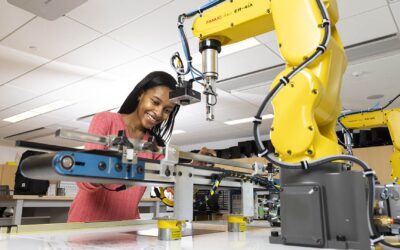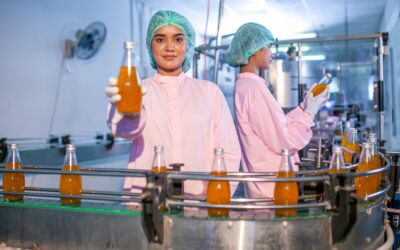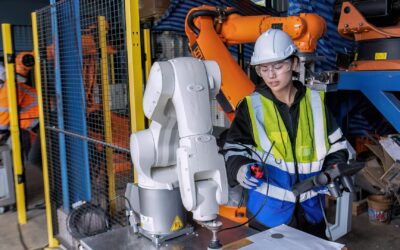Operating out of the U.P. in Hancock, MI, Chicken Tramper Ultralight Gear (CTUG) is a small hiking gear manufacturer employing a staff of nine. Its line of backpacks and accessories are designed to withstand harsh conditions while remaining light for distant hikes. The company prides itself as a brand for and by hikers.
As part of Michigan Economic Development Corporation’s (MEDC) Industry 4.0 Implementation Grant program, CTUG was awarded a $10,000 grant to bring its business to the Industry 4.0 level. The company used the funding to help purchase two digital automated sewing machines. With the new machines, the company is able to increase its production by programming complex stitching patterns into an onboard database.
Leading the team at CTUG is Co-founder Nathan Ackerman. The Michigan Tech engineering grad fell in love with hiking the great outdoors after a trek through the U.P.’s Copper Country. Ackerman’s first backpack was stitched out on his mother’s 30-year-old sewing machine. In 2019, the brand launched. Today its products are distributed to hikers everywhere on a national level.
Automation Alley sat down with Ackerman to discuss the grant, the new machines and being a part of the Industry 4.0 community.
What was your initial impression of Industry 4.0 technologies and the grant funding tied to them?
Initially we weren’t quite sure what it meant and what everything was. It took a while, but once we got into it, we realized we have a big community of people on the government and industry side getting together to help answer everyone’s questions and share stories about what they’ve done, what works well and what doesn’t work well.
They also pointed us in the right direction toward new technology and new machines. This was an amalgam of people getting together to boost all of manufacturing in Michigan, which sounded awesome. It was right where we are at as a manufacturer in Michigan and seemed like a no-brainer to us.
What was the problem you needed solved by this grant funding?
We do a lot of sewing and textile work at CTUG. Up to this point, most of our stuff was done on manual and industrial sized sewing machines. You had to hold a piece of fabric, feed it by hand, and manipulate the pedal. Sometimes the machine would stop with the needle up or the needle down, and you’d have to turn the machine by hand. To make a turn, you had to manually reverse all your directions to do your lock stitching at the beginning and the end of every stitch.
All of the movements like lining it up and making it straight was also done by the user. Also, all of the extra thread like tails gets left on the material so there will always be a little bit when you pull the material off the machine. You’d have to clip those off and usually they’re about 3-4 inch tails to trim off.
So the grants we received went toward a semi-digital sewing machine and a fully digital sewing machine.
How did the semi-digital and fully digital machines help automate your business?
The semi digital machine automatically does all the lock stitchings by itself as soon as you hit the pedal. It also tucks in the tail at the start of that stitch and double backs to cut all the tails. We can also program the machine to go a certain amount of stitches with the needle down, which is super helpful in doing boxes for Velcro and our logos. It was a huge help in going from fully manual machines to those.
Our time study showed we saved 30-40 man hours a month in just cutting the tails of the thread with the DDL 9000 machine.
Part of our grant also went toward a fully digital AMS 210 machine, which is a shape tacking machine. Instead of the person feeding the material in and manipulating everything, you can put a piece of fabric in, get a clamp to come down and hold onto it, and put another piece of fabric in, get a second clamp to hold onto it. Hit another button and the whole machine will go around and sew the product itself.
That’s tackling our really repetitive stuff: All of our accessories, boxes, straight line bar tacks, logos and Velcro. All of it is now done completely automated.
One, this makes things a lot easier and faster and two, it is super repeatable. Just with the box stitching, we’re saving another 40 hours a month. I haven’t finished a time study on the Velcro and logos, but I think with just that one machine we will see a savings of 80 hours a month, which is pretty crazy.
Another thing these machines help us with is training. It takes a really long time, anywhere from three to six weeks, to train someone up enough in manual sewing to make things fast and at high quality. With the new machine, I trained someone to operate it in two hours.
This increases our production and also our margins by decreasing the amount of time it takes to make everything.
Customers believe in a certain charm of handmade local goods. How do you reconcile adopting new technology that streamlines your process while keeping your local brand intact?
Sewing is an industry where machinery and technology can do quite a bit, but there are limits to things. We have a machine that can do boxes well, but it can’t do complicated trims. It can’t hold on to complicated pieces of fabric. We are trying to move away from having our skilled employees spend all of their time on repetitive small stuff easily done by a machine. This gives us the ability for us to train people up the ladder to make our more complicated products, like backpacks and camera bags.
Our fully automated machines do the tiny, super repetitive things that are super repetitive that all our employees hate doing. This machine makes everyone’s lives easier. No one is getting replaced.
What would you say to another small manufacturer about how the MEDC Industry 4.0 Implementation Grant could help them?
I would tell another small manufacturer to reach out and get more information. In addition to helping us get the grants, you helped us get equipment. Usually as a small business it is really hard to get capital and equipment: You go to a bank for a loan and they will deny it because you have no assets to offer as collateral. But Then you need to take on a loan to get collateral. It becomes a chicken and the egg game. But with the grant, you guys helped us so much by getting this equipment in there. On top of that, all of the people we’ve met during this process have been huge.
It is really hard as a small business to get your head out of “What do I have to get done this week?” But when you own a business, you have to think about six months from now, a year from now, and even globally. Having all the people we’ve met through here helped us do that and get a 10,000 ft view of the company in where we are going and what we’re doing.
Some of the technologies and businesses we have access to we would have never found on our own. Getting all the information fed to us is huge because it is really hard to go out and find the information you are looking for, and even if you do it might be at the wrong time or the wrong place.
This community has been a huge help to us in running our business and looking forward to where we are going: between streamlining things, cutting out waste, working faster and working better.
Sign up today for a free Essential Membership to Automation Alley to keep your finger on the pulse of digital transformation in Michigan and beyond.
Dennis Burck is Automation Alley's Digital Content Editor, responsible for the organization's content strategy and development. Dennis is a media-savvy professional who builds relationships with Automation Alley members and partners to find and create the best and most relevant content to increase Industry 4.0 awareness and drive traffic to Automation Alley's Industry 4.0 knowledge center.




